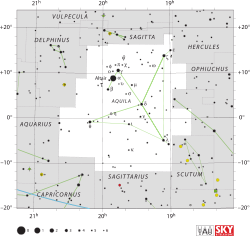Omega1 Aquilae
- For other star systems with this Bayer designation, see Omega Aquilae.

| |
| Observation data Epoch J2000.0 Equinox J2000.0 (ICRS) | |
|---|---|
| Constellation | Aquila |
| Right ascension | 19h 17m 48.99903s[1] |
| Declination | +11° 35′ 43.5291″[1] |
| Apparent magnitude (V) | 5.284[2] |
| Characteristics | |
| Spectral type | F0 IV[3] |
| U−B color index | +0.204[2] |
| B−V color index | +0.238[2] |
| Astrometry | |
| Radial velocity (Rv) | −14.3[4] km/s |
| Proper motion (μ) | RA: +0.94[1] mas/yr Dec.: +13.84[1] mas/yr |
| Parallax (π) | 7.86 ± 0.29[1] mas |
| Distance | 410 ± 20 ly (127 ± 5 pc) |
| Details | |
| Rotational velocity (v sin i) | 115[5] km/s |
| Other designations | |
| Database references | |
| SIMBAD | data |
Omega1 Aquilae (ω1 Aquilae, ω1 Aql) is the Bayer designation for a star in the equatorial constellation of Aquila. With an apparent visual magnitude of 5.2[2] it is a faint star that can be seen with the naked eye in dark skies. From the annual parallax shift of 7.86 mas, the distance to this star can be estimated as 410 light-years (130 parsecs), give or take a 20 light year margin of error.
The spectrum of this star fits a stellar classification of F0 IV.[3] Typically, a luminosity class of IV means that the star is in the subgiant stage. It is rotating rapidly with a projected rotational velocity of 115 km/s. This is causing an equatorial bulge that is 5% larger than the polar radius.[5]
References
- 1 2 3 4 5 van Leeuwen, F. (November 2007), "Validation of the new Hipparcos reduction", Astronomy and Astrophysics, 474 (2): 653–664, arXiv:0708.1752
 , Bibcode:2007A&A...474..653V, doi:10.1051/0004-6361:20078357.
, Bibcode:2007A&A...474..653V, doi:10.1051/0004-6361:20078357. - 1 2 3 4 Gutierrez-Moreno, Adelina; et al. (1966), A System of photometric standards, 1, Publicaciones Universidad de Chile, Department de Astronomy, pp. 1–17, Bibcode:1966PDAUC...1....1G.
- 1 2 Cowley, A.; et al. (April 1969), "A study of the bright A stars. I. A catalogue of spectral classifications", Astronomical Journal, 74: 375–406, Bibcode:1969AJ.....74..375C, doi:10.1086/110819.
- ↑ Wielen, R.; et al. (1999), Sixth Catalogue of Fundamental Stars (FK6). Part I. Basic fundamental stars with direct solutions (35), Astronomisches Rechen-Institut Heidelberg, Bibcode:1999VeARI..35....1W.
- 1 2 van Belle, Gerard T. (March 2012), "Interferometric observations of rapidly rotating stars", The Astronomy and Astrophysics Review, 20 (1): 51, arXiv:1204.2572
 , Bibcode:2012A&ARv..20...51V, doi:10.1007/s00159-012-0051-2.
, Bibcode:2012A&ARv..20...51V, doi:10.1007/s00159-012-0051-2. - ↑ "25 Aql -- Star", SIMBAD Astronomical Object Database, Centre de Données astronomiques de Strasbourg, retrieved 2012-07-21.
External links
This article is issued from Wikipedia - version of the 9/7/2016. The text is available under the Creative Commons Attribution/Share Alike but additional terms may apply for the media files.